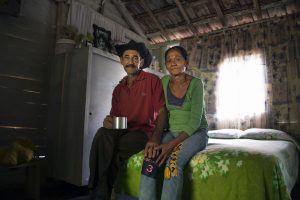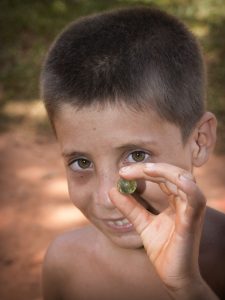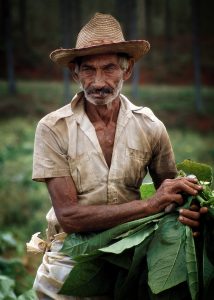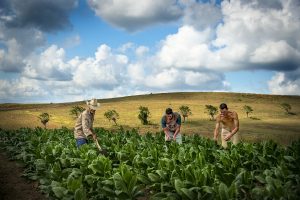TUSCALOOSA, Ala. – An exhibit featuring a series of photos taken in Cuba by Chip Cooper, faculty member and artist-in-residence at The University of Alabama’s Honors College, and Julio Ángel Larramendi Joa will be on display starting June 4 at the Massimiliano Massimo Institute in Rome in an exhibit titled “ Campesinos.” The exhibit is part of the celebration of the 80th anniversary of diplomatic relations between Cuba and the Vatican.

After the exhibit in Rome, which is scheduled to run a month, the photographs will travel to other Italian cities including Naples, Turin and Milan. The works previously were displayed in Havana in March 2015. The exhibit came about through communication between officials in the Vatican and the office of the Cuban ambassador to the Vatican.
Dr. Lourdes Alicia, former head of international relations for the University of Havana and wife of Rodney Alejandro López Clemente, Cuban ambassador to the Vatican’s Apostolic Palace, saw the exhibition in Havana in March, Cooper said. She told her husband about the show, and López in turn told officials at the Vatican. The communication resulted in the invitation to show Cooper’s and Larramendi’s work as part of the celebration.

The exhibit features 50 images – 25 each by Cooper and Larramendi. The works featured in the exhibit are from a collaborative project to chronicle the lives of campesinos, or peasant farmers, in Cuba. The University of Alabama Press will publish a book in 2016 featuring the photographs, titled “Campesinos, The Heart and Soul of Cuba.” The exhibit is culled from thousands of photographs taken by Cooper and Larramendi, a Cuban photographer who is visiting artist-in-residence at UA’s Honors College, from September 2014 to January 2015.
“I had met Julio in 2008 while working on a previous project,” Cooper said. “He helped me understand Havana and Cuba. He became my mentor during this project. We decided that we wanted to work on a book together, and we agreed to explore the life of the campesino.”
Cooper and Larramendi spent 16-hour days and traveled some 10,000 miles to complete the project.
“What we have both seen is that there are many books on Cuba’s cities but not the people,” Cooper said. “‘Campesinos’ captures the heart and soul of Cuba, the campesino, the country people. Larramendi and I have photographed all aspects of life in the rural countryside of Cuba — photographs that show a way of living that has not changed much in the last century. The photographs show Cuban landscapes and communities, children and education, work, social life, traditions, religion, houses and portraits of the people.”
On their travels, Cooper and Larramendi encountered Cuban people who had never seen an American before. In one town, Cooper said, a child saw him and said, “Mama, a Yuma.” “Yuma” is a word Cubans use to describe Americans, based on the 1950s western “3:10 to Yuma.”
“The love from the farmers and the friendships I developed were incredible. They always invited us into their lives as part of their family,” Cooper said.

Cooper began his work in Cuba through UA’s Alabama-Cuba Initiative, which since 2002 has brought UA and Cuban educators together to establish opportunities for graduate student research and teaching and formal course work for undergraduate students at Cuban academic institutions.
In 2008, Cooper joined with Cuban photographer Néstor Martí of the Havana Historian’s Office in documenting the oldest and most historically rich quarter in Cuba’s capital city at the invitation of Eusebio Leal Spengler, historian of the city of Havana and director of the Old Havana restoration project. The collaboration resulted in “La Habana Vieja,” a 228-page book with more than 200 photographs taken over a three-year period. It is also published by The University of Alabama Press.
Cooper credits Dr. Robert Olin, dean of UA’s College of Arts and Sciences, for his leadership of the Alabama-Cuba Initiative and for the support that made the publication of “La Habana Vieja” and “Campesinos” possible.
“He had extraordinary vision, and without him, these books that document a pivotal period in the life of the Cuban people and give insight into the rich culture of Havana wouldn’t have happened,” Cooper said.

UA’s Honors College also led University Fellows on 10-day academic trips each of the past three years.
More than 45 disciplines and departments, approximately 100 faculty, and nearly 75 graduate and undergraduate students at UA have participated in the initiative, made possible through an academic travel license from the U.S. Department of Treasury, which permits travel to Cuba for certain specific educational activities. Since its inception, more than 80 scholarly activities including articles, artworks, performances, exhibitions and books have been produced by UA faculty involved in the Alabama-Cuba Initiative.
Contact
Richard LeComte, media relations, rllecomte@ur.ua.edu, 205/348-3782
Source
Chip Cooper, ccooper@ur.ua.edu, 205/348-8329